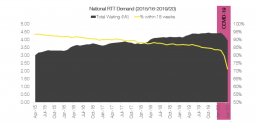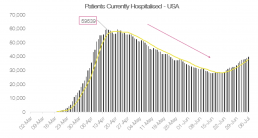
In the UK we have seen a growing fear over the use of any public facilities, despite which a noticeable increase in the number of patients waiting for treatment from a referral has been reported, coinciding with a decrease in the number of patients being seen within the 18-week target. This backlog of patients will fall within the recovery system of NHS trusts, as they try to reduce the number of stranded patients and get back to an efficiently running system. In a similar vein, the oncology sector is also seeing a backlog of patients waiting for cancer screenings, as there are usually roughly 210,000 screenings weekly, this rising to more than 2,100,000 patients left waiting after 10 weeks of lockdown. Clearly, this 10x increase in patients will result in an unnecessary spike in mortalities and is a vital point in the recovery from COVID-19.

Unsurprisingly, the USA still holds the most confirmed cases of COVID-19 in the world, and a noticeable trend in data is that, up to the 6th July, the number of cases is continuing to increase at an astronomical rate alongside the number of hospitalisations. While here in the UK, most people remain afraid of venturing into hospitals and to their GP’s due to the overworked healthcare service and fears of the virus, it seems that this may not be the case in the USA. Comparison of the two countries does not come so easily however, largely due to the vast disparity in COVID-19 case numbers, this perhaps contributing to the USA’s greater number of hospitalisations. However, the most interesting comparison is how the recovery methods in both countries will be tackled.

To say this month’s Recovery Insight Update Report is at the turning point of the pandemic would be putting it very lightly, as in most countries, government response policies have begun to ease as case numbers plateau. This creates a significant fork in the road for the ongoing progression of COVID-19 – will we see it dwindle out as the virus stops spreading thanks to the success of response policies and recovery, or will there be an influx of secondary peaks and COVID-19 waves reaching across the globe? To understand the current situation and response to the pandemic, we welcome anyone interested to download our Recovery Insight July Report here. Feel free to reach out to us at info@draperanddash.com.